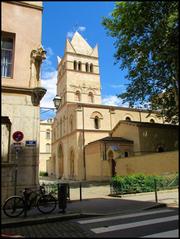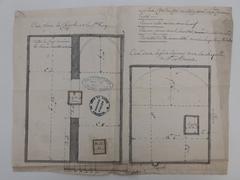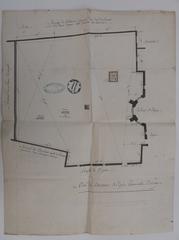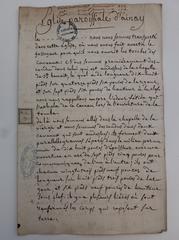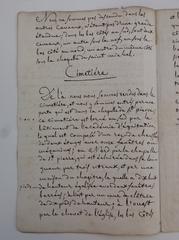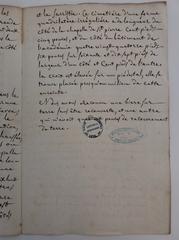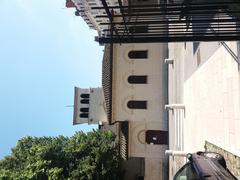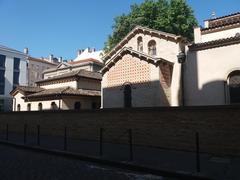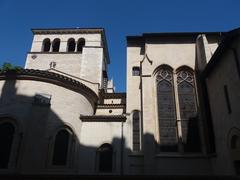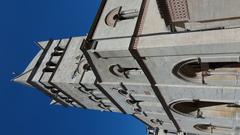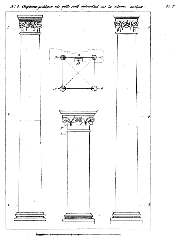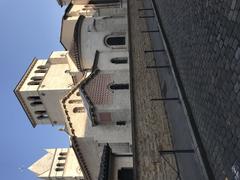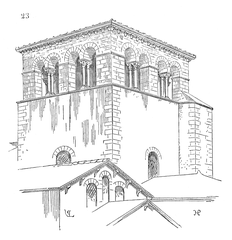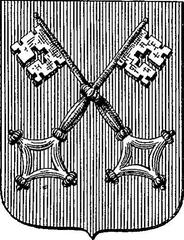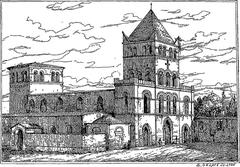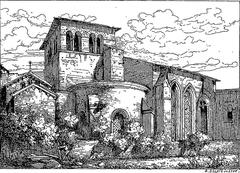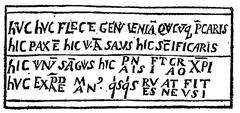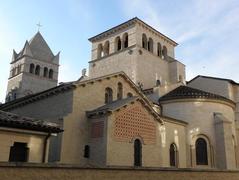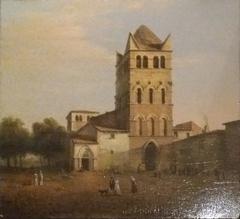Basilica of Saint-Martin d’Ainay, Lyon, France: Visiting Hours, Tickets, and Visitor Guide
Date: 14/06/2025
Introduction
Nestled in Lyon’s vibrant Presqu’île district, the Basilica of Saint-Martin d’Ainay stands as the city’s only surviving Romanesque church and a remarkable symbol of Lyon’s spiritual and architectural heritage. Built primarily in the 11th century and consecrated in 1107, the basilica embodies centuries of religious devotion, artistic achievement, and resilience through Lyon’s tumultuous history. Its distinctive features—including massive stone columns, intricately carved capitals, and a striking bell tower-porch constructed from repurposed Roman stones—invite visitors to explore a unique chapter of medieval France.
This comprehensive guide presents essential information for visitors, including historical context, architectural highlights, practical details for planning your visit, and tips for enjoying nearby attractions. Whether you are an architecture enthusiast, a history lover, or a traveler seeking authentic cultural experiences, the Basilica of Saint-Martin d’Ainay is an unmissable stop during your stay in Lyon (visitonslyon.com, Patrimoine-Lyon, Sacred Destinations).
Historical Overview
Early Foundations and Medieval Flourishing
The origins of the Basilica of Saint-Martin d’Ainay trace back to early Christian traditions of the 5th century. While local legend speaks of its foundation by the hermit Badulphe and the discovery of Lyon’s martyrs, archaeological evidence points to the existence of a monastic community by the early Middle Ages. The current Romanesque-style basilica was constructed in the late 11th century under the leadership of Abbot Gaucerand and consecrated by Pope Pascal II in 1107 (visitonslyon.com).
By the 13th century, the abbey had become a powerful religious institution, overseeing numerous churches in the region and playing a key role in the First Council of Lyon in 1245.
Turbulence, Decline, and Restoration
The basilica endured significant challenges during the 16th-century Wars of Religion, when its cloister and other monastic buildings were destroyed. During the French Revolution, the church was secularized and used as a grain store, an act that paradoxically aided its preservation when many other religious sites were lost (visitonslyon.com). Restoration efforts in the 19th century, led by architects Pollet and Benoît, revived the building, which was classified as a historic monument in 1844 and elevated to minor basilica status by Pope Pius X in 1905.
Architectural and Artistic Heritage
Romanesque Structure
The basilica’s architecture is characterized by robust, sober lines and harmonious proportions typical of Romanesque design. Its basilical plan features a nave with two aisles, a transept, and three apses. The 31-meter-high bell tower-porch, built from stones salvaged from Roman monuments, links the site’s Christian and ancient past (Patrimoine-Lyon).
Inside, massive cylindrical columns support barrel vaults, and the capitals are intricately carved with biblical scenes, stylized foliage, and symbolic animals. Some columns are believed to have originated from Lyon’s Sanctuary of the Three Gauls (visitonslyon.com).
Chapels and Artistic Details
- Chapel of Sainte Blandine: A pre-Romanesque chapel dedicated to one of Lyon’s earliest Christian martyrs, featuring a flat apse and semi-dome supported by sculpted capitals. The crypt beneath the chapel houses relic niches (Patrimoine-Lyon).
- Chapel of Saint-Michel: Originally Romanesque, this chapel received a flamboyant Gothic vault in the 15th century.
- Interior Artworks: Highlights include stained glass windows from several centuries, a grand 19th-century organ by Joseph Merklin, paintings by Hippolyte Flandrin, and a dome chandelier modeled after Frederick Barbarossa’s famous example (visitonslyon.com).
Archaeological Remains
Beneath the basilica, excavations have revealed mosaics and Merovingian sarcophagi, underscoring the site’s religious significance across the centuries (Patrimoine-Lyon).
Spiritual and Community Life
The basilica is an active parish church, hosting regular Masses, weddings, and community events (visitonslyon.com). Its enduring role as a place of worship reflects Lyon’s deep-rooted Christian heritage, and its elevation to minor basilica status in 1905 attests to its ongoing religious importance.
Location and Accessibility
- Address: Place d’Ainay, 69002 Lyon, France
- Metro: Ampère–Victor Hugo (Metro Line A), 5-minute walk
- Public Transport: Multiple bus lines serve the area
- Car: Parking available locally
The basilica is located in the heart of the Presqu’île district, within easy reach of other major Lyon historical sites (en.visiterlyon.com).
Visiting Hours, Tickets, and Practical Information
- Visiting Hours: Generally open daily from 9:00 AM to 6:00 PM. Hours may vary on religious holidays or for special events. Check the official parish website or call +33 4 72 77 61 74 for up-to-date information.
- Tickets: Admission is free; donations are appreciated.
- Guided Tours: Available by arrangement or during heritage events. Advance booking is recommended via the Lyon Tourism website.
- Accessibility: Wheelchair access is available via ramps at the main entrance. For other mobility accommodations, contact the basilica in advance.
Visitor Experience
Interior Ambience
The basilica’s thick stone walls and small Romanesque windows create a peaceful and contemplative atmosphere. The play of light on the stone and the scent of centuries past make for a unique experience, whether you visit for quiet reflection or to attend a service.
Photography and Etiquette
- Photography: Permitted without flash. Please be discreet and avoid taking photos during religious services.
- Conduct: Silence and respectful attire are expected, as the basilica is an active place of worship.
Nearby Attractions
The Basilica of Saint-Martin d’Ainay’s central location makes it a perfect starting point for exploring Lyon’s cultural riches:
- Place Bellecour: One of Europe’s largest squares, ideal for strolling and people-watching.
- Musée des Beaux-Arts de Lyon: A major art museum with collections spanning antiquity to modern times.
- Vieux Lyon (Old Lyon): Wander through Renaissance streets and discover hidden traboules (passageways).
- Musée des Tissus et des Arts Décoratifs: Explore Lyon’s textile history.
- Saône River Quays: Enjoy scenic river walks and the city’s vibrant café scene (routard.com).
Practical Tips for Visitors
- Best Time to Visit: Early mornings and weekdays are quieter.
- Weather: The basilica remains cool in summer and chilly in winter; dress appropriately.
- Language: Most signage is in French, but English information is available. Learning a few basic French phrases is helpful.
- Souvenirs: Postcards and guidebooks are occasionally available for purchase.
- Accessibility: While ramps are provided, some interior areas have uneven flooring. Contact the basilica for specific needs.
Frequently Asked Questions (FAQ)
Q: What are the basilica’s visiting hours?
A: Generally 9:00 AM–6:00 PM daily; hours may vary on holidays or for special events.
Q: Is there an entrance fee?
A: No, admission is free. Donations are welcome.
Q: Are guided tours available?
A: Yes, by prior arrangement or during special events.
Q: Is the basilica accessible to wheelchair users?
A: Yes, via ramps at the main entrance. Some interior areas may have limited accessibility.
Q: Can I take photographs inside?
A: Yes, but without flash and with discretion, especially during services.
Conclusion
The Basilica of Saint-Martin d’Ainay is a living monument bridging Lyon’s Roman roots and medieval Christian legacy. Its Romanesque architecture, remarkable chapels, and enduring spiritual role make it a must-see for visitors seeking to understand Lyon’s layered history. Free admission, regular hours, and a central location ensure that all visitors can enjoy this cultural and spiritual treasure.
For the latest updates, visiting hours, and guided tour options, consult the basilica’s official parish website and the Lyon Tourism portal. Enhance your experience with the Audiala app, offering personalized tours and real-time information about Lyon’s historical sites.
Sources
- Visiting the Basilica of Saint-Martin d’Ainay in Lyon: History, Architecture & Practical Guide, 2025, Lyon Tourism (https://en.lyon-france.com/)
- Basilica of Saint-Martin d’Ainay: Visiting Hours, Tickets, and Exploring Lyon’s Historic Romanesque Gem, 2025, Sacred Destinations (https://www.sacred-destinations.com/france/lyon-abbey-st-martin-d-ainay)
- Visiting the Basilica of Saint-Martin d’Ainay in Lyon: History, Hours & Tickets, 2025, Visitons Lyon (https://visitonslyon.com/en/the-basilica-of-ainay/)
- Basilica of Saint-Martin d’Ainay Visiting Hours, Tickets, and Visitor Guide in Lyon, 2025, Visiter Lyon (https://en.visiterlyon.com/discover/heritage-unesco/religious-heritage/saint-martin-d-ainay-basilica-abbey)
- Basilica of Saint-Martin d’Ainay – Wikipedia, 2025 (https://en.wikipedia.org/wiki/Basilica_of_Saint-Martin_d%27Ainay)
- Lyon Historical Sites and Cultural Guide, 2025, Routard (https://www.routard.com/fr/guide/france/lyon-et-ses-environs/lyon/presqu-ile/basilique-saint-martin-d-ainay)

